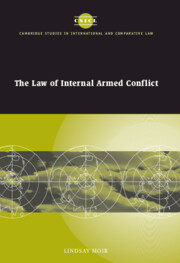Book contents
- Frontmatter
- Contents
- Preface and acknowledgements
- Table of cases
- Table of treaties and other international instruments
- 1 The historical regulation of internal armed conflict
- 2 Article 3 common to the Geneva Conventions
- 3 Additional Protocol II of 1977
- 4 Customary international law and internal armed conflict
- 5 Human rights during internal armed conflict
- 6 Implementation and enforcement of the laws of internal armed conflict
- Bibliography
- Index
- CAMBRIDGE STUDIES IN INTERNATIONAL AND COMPARATIVE LAW
5 - Human rights during internal armed conflict
Published online by Cambridge University Press: 07 July 2009
- Frontmatter
- Contents
- Preface and acknowledgements
- Table of cases
- Table of treaties and other international instruments
- 1 The historical regulation of internal armed conflict
- 2 Article 3 common to the Geneva Conventions
- 3 Additional Protocol II of 1977
- 4 Customary international law and internal armed conflict
- 5 Human rights during internal armed conflict
- 6 Implementation and enforcement of the laws of internal armed conflict
- Bibliography
- Index
- CAMBRIDGE STUDIES IN INTERNATIONAL AND COMPARATIVE LAW
Summary
Having examined the humanitarian law governing internal armed conflicts, it remains to consider what alternative or additional protection can be afforded to civilians through international human rights law. A detailed account of the origin and development of human rights is clearly outside the ambit of this book. For present purposes it will suffice to note that human rights essentially became an issue of international concern only after the atrocities of the Second World War.
Human rights and humanitarian law
There is undoubtedly a close relationship between humanitarian law and human rights law. Both are applicable during internal armed conflict – humanitarian law through specific provisions to that effect and through customary law, human rights in so far as they govern relations between a State and its subjects. Indeed, human rights law has had an important, and increasing, influence on the development of humanitarian law. There are, however, important differences.
First, the two legal regimes developed quite separately. International human rights developed in response to the barbarity of the Second World War, whereas humanitarian law first began to be codified at the international level in the nineteenth century. Of course both are considerably older in origin, and Pictet states that both date back as far as the human race, having the same initial objective – to protect the individual against those who would harm him.
- Type
- Chapter
- Information
- The Law of Internal Armed Conflict , pp. 193 - 231Publisher: Cambridge University PressPrint publication year: 2002
- 3
- Cited by

